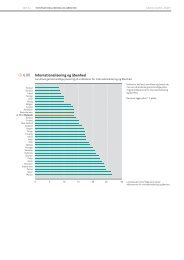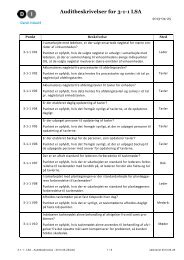Hydrogen and its competitors, 2004
Hydrogen and its competitors, 2004
Hydrogen and its competitors, 2004
Create successful ePaper yourself
Turn your PDF publications into a flip-book with our unique Google optimized e-Paper software.
44Risø Energy Report 3<strong>Hydrogen</strong> for transport5.4135Power densitites1,8100901,6801,4706050403020100Current PFIAdvancedHybridICE-GasolineCurrentAdvancedHybridICE-DieselCurrentAdvancedHybridICE-CNGLH2 from NGICE-H2Battery (electricity from the net)FC (CH 2 from NG)FC (LH 2 from NG)FC (gasoline reforming)ElectricFC (H from Renewables)1,21,00,80,60,40,20,019971998199920002001■ WTT ■ TTW■ kW/l ■ kW/kgFigure 21: Overall CO 2 emissions from different fuels <strong>and</strong> engine types.WTT=well to tank, i.e. emissions incurred in extracting, refining <strong>and</strong>distributing the fuel. TTW=tank to wheel, i.e. emissions created by thevehicle <strong>its</strong>elf. CNG=compressed natural gas.Figure 22: Technical progress in power density <strong>and</strong> specific power forPEMFCs over the last decade.• demonstrate the durability of individual components<strong>and</strong> the complete system;• develop high-efficiency thermal, water, <strong>and</strong> airmanagement subsystems;• develop <strong>and</strong> put in place a suitable fuel infrastructure;<strong>and</strong>• solve the problem of hydrogen storage.The last point, storage, is the biggest research problemremaining in the development of hydrogen-poweredvehicles. <strong>Hydrogen</strong>'s low density makes it difficult tostore sufficient amounts on board a vehicle to achieve auseful range without the container being too large or tooheavy.Currently, hydrogen must be either pressurised to severalhundred atmospheres or stored as a liquid at cryogenictemperatures. Neither of these options are appropriatefor normal road vehicles. There has therefore been muchresearch into new storage technologies such as carbonnanotubes <strong>and</strong> metal hydrides, both of which can theoreticallyhold large amounts of hydrogen safely in a relativelysmall space (see also Chapter 5.2). The difficulty ofthis research, however, is shown by the extremely lowlevel of patenting in this area.Market projections <strong>and</strong> cost targetsIt is difficult to predict the market share of fuel cells infuture transport applications, since a significant marketfor fuel cell vehicles cannot emerge until the currenttechnical <strong>and</strong> infrastructure challenges have beensolved. Fuel cells also have to compete with gasoline <strong>and</strong>diesel ICE technologies, which also are improved continuously.Figure 23 combines the results of several studies to give aqualitative view of how fuel cell vehicle sales may grow.It is important to remember that estimates of the potentialmarket for fuel cells in the transport sector vary enormouslyin terms of both value <strong>and</strong> number. Uncertaintiesassociated with fuel cell technology are probablyresponsible for the fact that no such market studies havebeen published since 2002.A study by Allied Business Intelligence (ABI), not shownin Figure 23, predicts a market in the range $608,000-$1.2 million for fuel cell vehicles in the USA by 2010, <strong>and</strong>a global market of $1.5 million by 2011, accounting for2.7% of all new road vehicles. New regulatory incentivesor unexpected technical progress could increase theglobal market to $2.4 million, or 4.3% of all vehicles,according to ABI. The study suggests that the number ofvehicles produced could reach 800,000 by 2012.It is highly significant that METI, the Japanese Ministryof Economy, Trade <strong>and</strong> Industry, at the end of 2003announced that it forecasts an eventual total of 50,000fuel cell vehicles on Japanese roads. Also important is thefact that electric vehicles are already available for leasingfrom car manufacturers including Toyota, Honda,Nissan, DaimlerChrysler <strong>and</strong> Opel. 7Notwithst<strong>and</strong>ing the different forecasts for growth rate<strong>and</strong> eventual market size, most experts believe that fuelcells will not enter the vehicle market in commercialnumbers until after 2015. The reason is because of thetime needed for testing, first in niche areas <strong>and</strong> then insmall fleets.Fuel cell vehicles also need to be supported by a distributioninfrastructure for hydrogen. At the start, with veryfew hydrogen vehicles on the market, refuelling stations7. Toyota, for example, leases <strong>its</strong> FCHV4 vehicle at $10,000 per month.
















